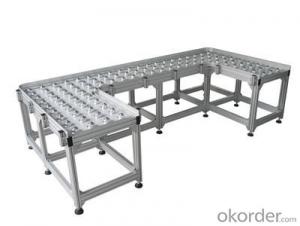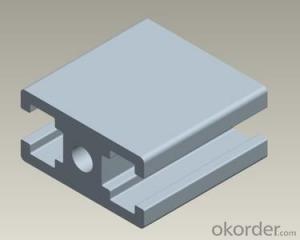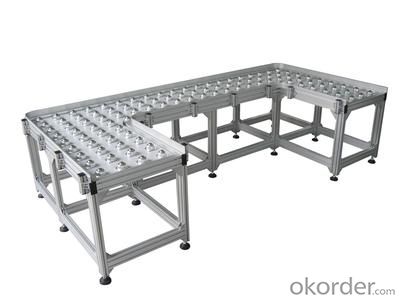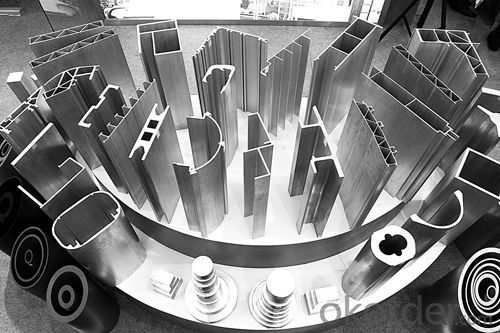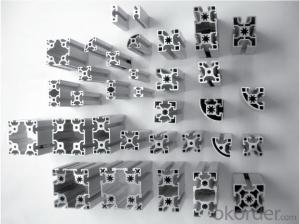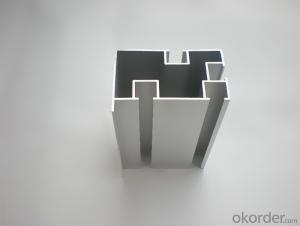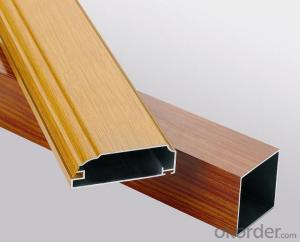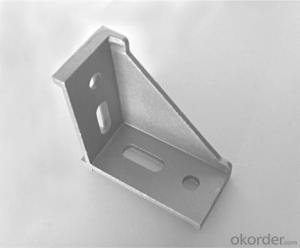Extruded Aluminum Profiles China - Alloy 6063, 6061, 6005 Aluminum Profile
- Loading Port:
- China Main Port
- Payment Terms:
- TT OR LC
- Min Order Qty:
- -
- Supply Capability:
- -
OKorder Service Pledge
OKorder Financial Service
You Might Also Like
Aluminium is a relatively soft,durable, lightweight, ductile and malleablemetal with appearance ranging from silvery to dull gray,depending on the surface roughness. It is nonmagnetic and does not easilyignite. A fresh film of aluminium serves as a good reflector (approximately92%) of visible light and an excellent reflector (as much as98%) of medium and far infrared radiation. The yield strength of pure aluminium is 7–11 MPa,while aluminium alloys have yield strengths ranging from200 MPa to 600 MPa. Aluminium has about one-third the density and stiffnessof steel. It iseasily machined,cast, drawn and extruded.
Alu Profile:
Material | Alloy 6063,6061,6005or according to customer’s choice |
Temper | T3, T4, T5, T6 |
Surface | Anodize, electrophoresis, powder coating, PVDF coating, wood grain painting, matted, etc. |
Length | Coating 6.5 meters, Anodizing 6.5 meters, Mill finish 5 meters |
Application | Industrial, electrical equipment(TV set, air conditioner, refrigerator, computer), decoration,construction, transportation |
Custom Made | We can package following with customer's request. |
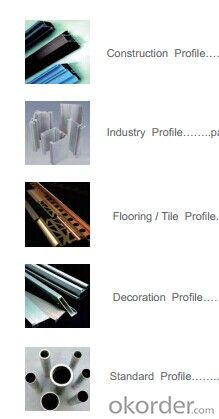
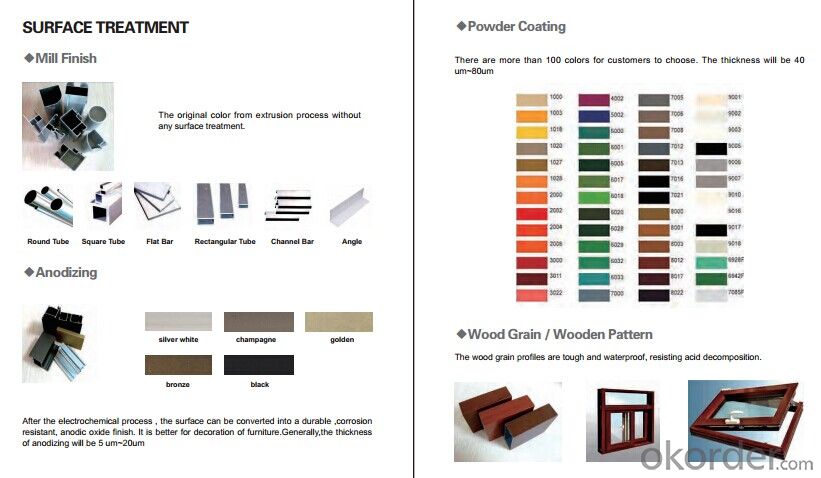

FAQ:
1. What is the form of payment?
Normally 30% TT, L/C at sight
2. Type of quotation?
FOB, CFR, CIF
3. Port of loading?
Guangzhou/Shenzhen port
4. Delivery time?
15-20 days after client’s deposit
- Q: Is it possible to utilize aluminum profiles in the construction or structure of commercial buildings and factories?
- <p>Yes, aluminum profiles are commonly used in commercial buildings and factories due to their strength, durability, and lightweight properties. They are ideal for constructing frameworks, window and door frames, and support structures. The corrosion resistance of aluminum also makes it suitable for industrial environments where exposure to harsh chemicals or weather conditions is a concern. Additionally, aluminum profiles are easy to maintain and can be recycled, contributing to the sustainability of construction projects.</p>
- Q: What are the surface hardness properties of aluminum profiles?
- The surface hardness of aluminum profiles can differ depending on the specific alloy and treatment processes used. In comparison to metals like steel, aluminum alloys generally have lower hardness. However, by employing various treatments, aluminum profiles can achieve improved surface hardness. One commonly used treatment method is anodizing, which involves the creation of an oxide layer on the aluminum surface. Not only does this process enhance the corrosion resistance of the profiles, but it also increases their surface hardness. Depending on the thickness of the oxide layer, anodized aluminum profiles can have a hardness ranging from 150 to 300 HV (Vickers hardness). Another treatment process is hard coating, where a ceramic material like aluminum oxide is applied to the surface of the profiles. This coating drastically enhances the hardness of the aluminum, providing a higher level of wear resistance. The hardness of hard-coated aluminum profiles can range from 400 to 600 HV or even higher. It is important to note that the specific hardness properties can vary based on the alloy composition, surface treatment method, and intended application of the aluminum profiles. Hence, it is crucial to consult manufacturers or suppliers to determine the appropriate hardness properties that best suit your specific needs.
- Q: How do aluminum profiles perform in terms of energy efficiency?
- Aluminum profiles possess outstanding energy efficiency properties, making them widely utilized in numerous industries and applications, including construction, transportation, and manufacturing. Their ability to contribute to energy savings and sustainability is well-known. The lightweight nature of aluminum is one of the key reasons for its energy efficiency. In comparison to materials like steel, aluminum profiles are considerably lighter, resulting in reduced energy requirements for transportation and installation. This, in turn, decreases the overall carbon footprint associated with the manufacturing and use of aluminum profiles. Furthermore, aluminum exhibits high thermal conductivity, enabling efficient heat transfer. This characteristic proves particularly advantageous in windows and doors applications. By efficiently regulating the transfer of heat between a building's interior and exterior, aluminum profiles diminish the need for excessive heating or cooling, thereby leading to energy savings and reduced energy consumption. Moreover, aluminum profiles readily integrate with additional energy-efficient components, such as thermal breaks and insulating materials. These additions further enhance the energy performance of aluminum profiles by minimizing thermal bridging and enhancing insulation, thereby reducing energy loss. Additionally, aluminum is an extremely durable and long-lasting material. This durability translates to structures and products made with aluminum profiles requiring less maintenance and replacement over time. Consequently, this attribute contributes to overall energy efficiency by reducing the energy and resources needed for repairs and replacements. In conclusion, aluminum profiles are highly esteemed for their energy efficiency characteristics. Their lightweight nature, excellent thermal conductivity, compatibility with energy-efficient components, and long-term durability make them a sustainable choice that can foster energy savings and minimize environmental impact across various applications.
- Q: Is it possible to recycle aluminum profiles and use them again in construction?
- <p>Yes, aluminum profiles can be recycled and reused in building construction. Aluminum is highly recyclable, and the recycling process requires significantly less energy compared to producing new aluminum. Recycled aluminum maintains its strength and properties, making it suitable for various construction applications. This practice not only conserves resources but also reduces waste and environmental impact.</p>
- Q: This question asks for a comparison of aluminum profiles with other materials regarding their weight and strength characteristics.
- <p>Aluminum profiles are known for their high strength-to-weight ratio, making them lighter than many other materials while maintaining significant strength. Compared to steel, aluminum is approximately one-third the weight but offers comparable strength, especially in alloy forms. When compared to plastics, aluminum profiles have greater rigidity and durability. They also resist corrosion and are more heat resistant than many plastics. However, aluminum profiles are generally more expensive than plastics and some steels. In summary, aluminum profiles offer a balance of low weight and high strength, making them suitable for applications where weight savings and structural integrity are crucial.</p>
- Q: Can aluminum profiles be used in corrosive environments?
- Aluminum profiles can be used in corrosive environments, but it is important to consider certain factors before making a decision. Aluminum is naturally resistant to corrosion due to the formation of a protective oxide layer on its surface. This layer acts as a barrier, preventing further corrosion. However, in highly corrosive environments such as areas with high humidity, saltwater exposure, or acidic conditions, the protective oxide layer may deteriorate over time. To enhance the resistance of aluminum profiles in corrosive environments, various measures can be taken. One option is to choose an aluminum alloy with higher corrosion resistance, such as aluminum alloys with a higher percentage of alloying elements like copper or zinc. These alloys are often referred to as marine-grade or corrosion-resistant alloys. Additionally, surface treatments like anodizing or powder coating can further improve the corrosion resistance of aluminum profiles. Anodizing involves the formation of a thicker and more durable oxide layer on the surface of the aluminum, while powder coating provides an additional protective layer that acts as a barrier against corrosive agents. Regular maintenance and cleaning are also crucial for preserving the corrosion resistance of aluminum profiles in corrosive environments. This includes removing any accumulated dirt or debris that may contain corrosive substances. In summary, while aluminum profiles can be used in corrosive environments, it is essential to select the appropriate alloy, consider surface treatments, and perform regular maintenance to ensure their long-term performance and durability.
- Q: How are the tonnage grades of aluminum extrusion machines classified?
- The day songs colored object if the method of food
- Q: What is the difference between the two, or how to distinguish it from the outdoor curtain wall?
- Aluminum material refers to the blank material, which is used directly without artificial aging
- Q: Can aluminum profiles be used in the construction of modular office spaces?
- Yes, aluminum profiles can be used in the construction of modular office spaces. Aluminum profiles are lightweight, durable, and corrosion-resistant, making them an ideal choice for modular construction. They can be easily fabricated into various shapes and sizes, allowing for versatility in design. Additionally, aluminum profiles offer excellent thermal insulation properties and can be easily integrated with other building components, such as glass panels or insulation materials.
- Q: The user is asking if it's possible to use recycled aluminum to create new aluminum profiles.
- <p>Yes, recycled aluminum can be used to produce new aluminum profiles. The process of recycling aluminum is energy-efficient and environmentally friendly, as it requires significantly less energy compared to producing aluminum from raw materials. Recycled aluminum maintains the same properties as new aluminum, making it suitable for manufacturing various aluminum profiles. The recycling process typically involves melting the aluminum, which can then be cast into new shapes and forms, including profiles for construction, automotive, and other industries. This not only conserves resources but also reduces waste and carbon emissions.</p>
Send your message to us
Extruded Aluminum Profiles China - Alloy 6063, 6061, 6005 Aluminum Profile
- Loading Port:
- China Main Port
- Payment Terms:
- TT OR LC
- Min Order Qty:
- -
- Supply Capability:
- -
OKorder Service Pledge
OKorder Financial Service
Similar products
Hot products
Hot Searches
Related keywords
